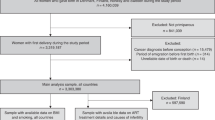Because of the reduced risk of ovarian cancer related to prior full-term pregnancies, we sought to determine whether there was any association with a history of one or more incomplete pregnancies. White female residents of three counties in Washington State (United States) diagnosed with ovarian cancer during 1986–88 (n=322), and a random sample of control women selected from these same counties (n=426), were interviewed regarding their pregnancy and childbearing histories. Among women who had given birth to at least one child, an additional incomplete pregnancy was not associated with the risk of ovarian cancer (relative risk [RR]=1.1, 95 percent confidence interval [CI]=0.8–1.6, adjusting for age, oral contraceptive use, and number of births). For those who had never given birth, a somewhat smaller proportion of cases had a history of incomplete pregnancy than controls (RR=0.8, CI=0.4–1.7). In an analysis restricted to ever-pregnant women, a prior induced or spontaneous abortion was not found to be associated with the incidence of ovarian tumors (RR=1.0, CI=0.6–1.7, and RR=1.3, CI=0.8–1.9, respectively). Other studies of the possible relation between incomplete pregnancies and ovarian cancer generally have observed either a weak negative association or no association at all. It is possible that if incomplete pregnancies do affect the risk of ovarian cancer, their impact might be too small to be identified reliably through epidemiologic studies.
Similar content being viewed by others
References
Baker TR, Piver MS. Etiology, biology, and epidemiology of ovarian cancer. Semin Surg Oncol 1994; 10: 242–8.
Negri E, Franceschi S, Tzonou A, et al. Pooled analysis of 3 European case-control studies: I. Reproductive factors and risk of epithelial ovarian cancer. Int J Cancer 1991; 49: 50–6.
Whittemore AS, Harris R, Itnyre J, et al. Characteristics relating to ovarian cancer risk: collaborative analysis of 12 US case-control studies. Am J Epidemiol 1992; 136: 1184–203.
Gwinn ML, Lee NC, Rhodes PH, Layde PM, Rubin GL. Pregnancy, breast feeding, and oral contraceptives and the risk of epithelial ovarian cancer. J Clin Epidemiol 1990; 43: 559–68.
Adami HO, Hsieh C-c, Lambe M, et al. Parity, age at first childbirth, and risk of ovarian cancer. Lancet 1994; 344: 1250–4.
Fathalla MF. Incessant ovulation—a factor in ovarian neoplasia? Lancet 1971; 2: 163.
Casagrande JT, Louie EW, Pike MC, Roy S, Ross RK, Henderson BE. ‘Incessant ovulation’ and ovarian cancer. Lancet 1979; 2: 170–3.
Stadel BV. The etiology and prevention of ovarian cancer. Am J Obstet Gynecol 1975; 123: 772–4.
West RO. Epidemiologic study of malignancies of the ovaries. Caner 1966; 19: 1001–7.
Wynder EL, Dodo H, Barber HRK. Epidemiology of cancer of the ovary. Cancer 1969; 23: 352–70.
Kvåle G, Heuch I, Nilssen S, Beral V. Reproductive factors and risk of ovarian cancer: a prospective study. Int J Cancer 1988: 42: 246–51.
Purdie D, Green A, Bain C, et al. Reproductive and other factors and risk of epithelial ovarian cancer: an Australian case-control study. Int J Cancer 1995; 62: 678–84.
Shu XO, Brinton LA, Gao YT, Yuan JM. Population-based case-control study of ovarian cancer in Shanghai. Cancer Res 1989: 40: 3670–4.
Polychronopoulou A, Tzonou A, Hsieh C-c, et al. Reproductive variables, tobacco, ethanol, coffee and somatometry as risk factors for ovarian cancer. Int J Cancer 1993; 55: 402–7.
Negri E, Franceschi S, laVecchia C, Parazzini F. Incomplete pregnancies and ovarian cancer risk. Gynecol Oncol 1992; 47: 234–8.
Mori M, Harabuchi I, Miyake H, et al. Reproductive, genetic, and dietary risk factors for ovarian cancer. Am J Epidemiol 1988; 128 771–7.
Waksberg J. Sampling methods for random digit dialing. J Am Stat Assoc 1978; 73: 40–6.
Wilcox A, Horney LF. Accuracy of spontaneous abortion recall. Am J Epidemiol 1984; 120: 727–33.
Axelsson G, Rylander R. Validation of questionnaire reported miscarriage, malformation and birth weight. Int J Epidemiol 1984; 13: 94–8.
Tilley BC, Barnes AB, Bergstralh E, et al. A comparison of pregnancy history recall and medical records-implications for retrospective studies. Am J Epidemiol 1985; 121: 269–81.
Jones EF, Forrest JD. Underreporting of abortion in surveys of U.S. women: 1976 to 1988. Demography 1992; 29: 113–26.
Author information
Authors and Affiliations
Additional information
This research was supported in part by a grant from the US National Cancer Institute (R35 CA39779), and by the Cancer Surveillance System of the Fred Hutchinson Cancer Research Center, which is funded by Contract No. N01-CN-05230 from the Surveillance, Epidemiology and End Results (SEER) program of the National Cancer Institute with additional support from the Fred Hutchinson Cancer Research Center.
Rights and permissions
About this article
Cite this article
Chen, MT., Cook, L.S., Daling, J.R. et al. Incomplete pregnancies and risk of ovarian cancer (Washington, United States). Cancer Causes Control 7, 415–420 (1996). https://doi.org/10.1007/BF00052667
Received:
Accepted:
Issue Date:
DOI: https://doi.org/10.1007/BF00052667



